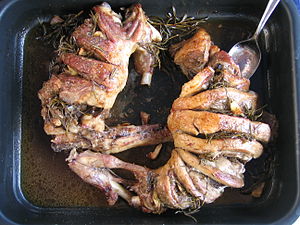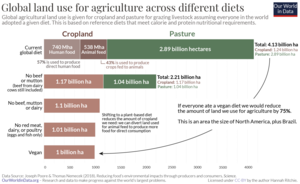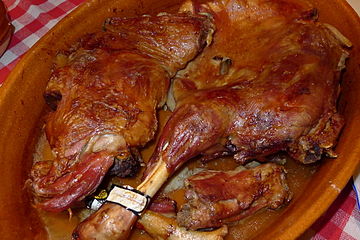Lamb and mutton/ja: Difference between revisions
Created page with "=== 羊肉の生産 === 以下の表は、生産国のサンプルを示しているが、50〜120ktの範囲にある他の多くの重要な生産国は示されていない。" |
Created page with "== 料理 == thumb|[[Wikipedia:Kendall-Jackson|Kendall-Jacksonワインエステートで直火焼きされているラムの脚]] thumb|[[:en:Croatia|クロアチア・パグ島のノヴァリャで串焼きにされるラム(手前)]] ヒツジの肉は、ギリシャ、クロアチア..." |
||
| Line 173: | Line 173: | ||
|} | |} | ||
== 料理 == | |||
== | [[File:Kendall-Jackson May Farm-To-Table Dinner - Stierch 04.jpg|thumb|[[Wikipedia:Kendall-Jackson|Kendall-Jackson]]ワインエステートで直火焼きされているラムの脚]] | ||
[[File:Kendall-Jackson May Farm-To-Table Dinner - Stierch 04.jpg|thumb| | [[File:Janjetina i odojak na ražnju u Novalji.2.jpg|thumb|[[:en:Croatia|クロアチア]]・パグ島の[[:en:Novalja|ノヴァリャ]]で串焼きにされるラム(手前)]] | ||
[[File:Janjetina i odojak na ražnju u Novalji.2.jpg|thumb| | ヒツジの肉は、[[Greek cuisine/ja|ギリシャ]]、[[Croatian cuisine/ja|クロアチア]]、[[Turkish cuisine/ja|トルコ]]、[[Cuisine of Africa/ja#North Africa|北アフリカ]]、[[:en:Jordan|ヨルダン]]、[[Middle Eastern cuisine/ja|中東]]を含むいくつかの[[Mediterranean cuisine/ja|地中海料理]]文化、さらに[[:en:Iran|イラン]]や[[:en:Afghanistan|アフガニスタン]]の料理において重要な位置を占めている。例えばギリシャでは、多くの食事や復活祭のような宗教的饗宴に欠かせない要素であり、''[[avgolemono/ja|アヴゴレモノ]]''や''[[magiritsa/ja|マギリッツァ]]''のような料理に使われている。[[Basque cuisine/ja|バスク]]文化でも人気があり、ヨーロッパのバスク地方だけでなく、アメリカ西部の牧羊地域でも(1850年代から活動している[[:en:Basque Americans#Migration and sheepherding|バスク系の牧羊者]]によって)広まっている。アメリカ合衆国では、[[:en:Navajo|ナバホ]]が17世紀にスペイン人探検家や入植者によって羊を導入されて以来、伝統料理にマトンやラムを取り入れており、野生のシチメンチョウやシカに代わって牧畜文化を形成した。[[:en:Northern Europe|北ヨーロッパ]]では、マトンやラムは多くの伝統料理に登場し、[[Cuisine of Iceland/ja|アイスランド]]、[[Norwegian cuisine/ja|ノルウェー]]、[[British cuisine/ja|イギリス]]の料理に含まれている。 | ||
<div lang="en" dir="ltr" class="mw-content-ltr"> | <div lang="en" dir="ltr" class="mw-content-ltr"> | ||
Revision as of 18:08, 25 August 2025


ラム肉とマトン、総称して羊肉(またはシープミート)は、世界で最も一般的な肉の一つであり、家羊 Ovis aries から得られ、一般的に、生後1年以内の羊から得られるラム、2年目の羊から得られるホゲット、それ以上の年齢の羊から得られるマトンに分けられる。一般的に、「ホゲット」と「羊肉」という語は、ノルウェー、ニュージーランド、南アフリカ、スコットランド、オーストラリア以外の消費者には用いられない。ホゲットは、特にイングランド北部(ランカシャーおよびヨークシャー)でより一般的になりつつあり、希少品種や有機農業と関連していることが多い。
南アジア料理やカリブ料理において、「マトン」はしばしばヤギ肉を意味する。様々な時代や地域において、「マトン」や「ゴートマトン」がヤギ肉を意味する場合があった。
ラム肉は3種類の中で最も高価であり、近年では羊肉は「ラム」としてのみ販売されることが増え、上述の区別が曖昧にされることもある。より強い風味を持つマトンは、多くの地域で入手が困難になっており、イギリスのMutton Renaissance Campaignによる普及活動にもかかわらず、その状況は続いている。オーストラリアでは、肉用に飼育されたラムを指す語としてプライムラムがよく用いられる。フランス語、スペイン語、イタリア語などの言語では、羊肉を年齢や場合によっては性別や飼料に応じて同様、もしくはさらに詳細に区別しており、例えばスペイン語のlechazoは母乳で育てられた(離乳していない)子羊の肉を指す。
分類と命名

ラム、ホゲット、マトンの定義は国によって大きく異なる。若いラムは小さく、肉質が柔らかい。マトンは2年以上の羊の肉であり、肉質が硬い。一般的に、色が濃いほど動物が年を取っている。
イギリス、オーストラリア、ニュージーランド
- ラム
- 生後1年未満の若い羊。2019年7月1日から、オーストラリアにおける定義は「(a) 12か月未満である、または (b) 永久切歯が摩耗していないヒツジ」とされた。この新しい定義により、オーストラリアの農家は「ラム」と呼べる期間を1か月延長できるようになった。これは2018年のニュージーランドにおける定義変更に続くものである。イギリスでは依然として「永久切歯が0本」という定義である。永久切歯が摩耗している(in wear)とは、それが隣接する乳歯より突き出している場合を指す。
- ホゲット
- 永久切歯が2本以下で摩耗している羊(性別を問わない)。この語はその羊の肉を指すのにも用いられる。イギリスでは11~24か月齢の羊を指し、オーストラリアの精肉業者は13~24か月齢の羊に用いる。農業や専門精肉業者の間では依然として一般的だが、イギリス、オーストラリア、ニュージーランドのスーパーマーケットでは、2年未満の羊の肉はすべて「ラム」と呼ばれる傾向があり、ホゲットという語は稀である。
- マトン
- 永久切歯が2本以上摩耗している雌(雌羊)または去勢された雄(去勢羊)の肉。
イタリア

ロマネスコ方言において、まだ授乳中もしくは離乳直後の子羊はアバッキオと呼ばれ、すでに2回毛刈りされたほぼ1歳の子羊はagnello(lit. 'ラム')と呼ばれる。この区別はロマネスコ方言にのみ存在する。アバッキオはイタリア中部全域で復活祭やクリスマスの料理として食される。これは欧州連合によりPGIマークで保護された製品である。
イタリア中部全域、特にサルデーニャを含む地域において、牧畜は主要な肉の供給源であった。古代から、アバッキオはラツィオ州の主食の一つであり、特に農村地域の人々にとって食卓での消費量は多かった。アバッキオの消費の伝統は、古代には主に成羊が屠殺される場所に広まった。アバッキオの屠殺は復活祭とクリスマスの期間および6月までしか許されなかった。食材としての重要性から、ラツィオでは羊肉を調理する100種類近いレシピが発展した。社会生活におけるアバッキオの重要性から、現在でもラツィオ州ではサグラと呼ばれる祭りや農村祭、民俗行事が開催されている。古代においては、羊肉は畑仕事の際に食され、アバッキオは復活祭の休日にのみ食べられていた。
南アジア

「マトン」という語は南アジアのほとんどの国でヤギ肉を指し、ヤギの飼育数は増加している。例えば、マトンカレーは常にヤギ肉で作られる。毎年ヤギの3分の1以上が屠殺され、マトンとして販売されていると推定されている。インドおよびインド亜大陸の家羊の数は40年以上減少傾向にあり、山岳地帯において野生羊を基にした品種がわずかに残っており、主に羊毛生産のために飼育されている。
しかし、インドの一部の州(例えばアーンドラ・プラデーシュ州やテランガーナ州)では羊肉も人気がある。
アメリカ合衆国
20世紀初頭には、マトンはアメリカ合衆国で広く消費されていたが、第二次世界大戦以降、マトンの消費は減少した。2010年当時、アメリカ合衆国で流通している羊肉のほとんどは12~14か月齢の羊から得られ、「ラム」と呼ばれている。「ホゲット」という語は用いられない。USDA等級は羊の年齢だけではなく、他の要素によっても決まる。20か月齢までの動物であっても、他の条件次第では「USDAプライム」等級に達することがあり、「USDAチョイス」ラムは年齢を問わない。「スプリングラム」はUSDAによって3月から10月の間に屠殺されたものと定義されている。
その他の種類

- 吸乳子羊またはミルクラム
- 離乳していない子羊の肉で、通常4~6週齢、体重5.5~8kg程度。アメリカやイギリスなどでは一般に入手できない。スペインでチュレティージャスとして知られる小さなラムチョップの炭火焼きや、レチャソ・アサードまたはコルデロ・レチャル・アサードとして知られるローストは、一般に成長したラムよりも風味や食感が優れていると考えられ、高値で取引される。これが見られるスペイン北部の地域には、アストゥリアス、カンタブリア、カスティーリャ・イ・レオン州、ラ・リオハ州が含まれる。ミルクラムは特にギリシャでの復活祭に重宝され、串焼きにされる。
- 若いラム
- 生後6~8週齢の母乳で育ったラム
- スプリングラム
- 通常、生後3~5か月齢で、冬の終わりから春に生まれ、(北半球では)7月1日以前に販売されるラム
- サッカーラム
- オーストラリアで用いられる語で、若いミルクラムや、母乳に依存している生後約7か月までのやや成長したラムを含む。これらの枝肉の重量は通常14~30kgである。離乳後、まだマトンに成長していないラムは「オールドシーズンラム」と呼ばれる。
- 1歳羊(イヤリングラム)
- 生後12~24か月齢の羊
- ソルトブッシュマトン
- オーストラリアで、アトリプレックス植物を放牧して育てた成熟したメリノ種の肉を指す語
- ソルトマシュラム
- (saltmarsh lamb またはフランス語のagneau de pré-saléとしても知られる)潮の干満で覆われる沿岸の塩性湿地で、シーフェンネル、スパルタ草、スイバ、ハマボウフウなどの塩分耐性草本を食べて育った羊の肉。湿地の場所によって植物の種類は微妙に異なる。ソルトマシュラムはフランスで長く珍重されており、イギリスでも人気が高まっている。イギリスでソルトマシュラムが飼育されている地域には、ウェールズのハーレックやガワー半島、サマセット・レベルズ、モーカム湾、ソルウェー湾がある。
- ソルトグラスラム
- フリンダース島(タスマニア)特有のラム。島の牧草は比較的高い塩分を含み、ソルトマシュラムに似た風味と食感を持つ。
精肉と料理
ラム肉は生後1か月から1年の子羊から得られ、枝肉重量は5.5 and 30 kg (12 and 66 lb)である。この肉は一般に成羊の肉より柔らかく、いくつかの西洋諸国の食卓により多く上る。ホゲットとマトンは、種特有の脂肪酸濃度が高いためラムよりも風味が強く、それを好む人もいる。マトンとホゲットは結合組織の成熟によりラムより硬くなる傾向があり、そのためランカシャーホットポットのような煮込み料理に適している。
ラム肉はしばしばフォークォーター、ロイン、ハインドクォーターの3種類に分類される。フォークォーターには首、肩、前脚、肩甲骨までの肋骨が含まれる。ハインドクォーターには後脚と腰が含まれる。ロインはその間の肋骨部分を指す。
ラムチョップは肋骨、ロイン、肩の部位から切り出される。リブチョップには肋骨が含まれ、ロインチョップには脊椎骨(背骨)が含まれる。肩チョップは通常ロインチョップより劣るとされ、両方ともグリルされることが多い。ラムの胸肉(ベビーチョップ)はオーブンで調理できる。
ラムレッグは脚全体、サドルは腰を含む2つのロインを指す。レッグとサドルは通常ローストされるが、レッグは煮ることもある。
羊のフォークォーター部位は、他の哺乳類と同様に結合組織が多く、若いラムでない限り、蒸し煮やシチューのような湿潤調理法、または低温ロースト、アメリカ式バーベキューでゆっくり調理するのが最適である。いくつかの国では既に細かく切られた状態で販売される。
ラムシャンクの定義はさまざまであるが、一般的には以下を含む:
- 肩の腕から切り出され、脚の骨と肩の一部を含み、薄い脂肪層とフェル(紙のように薄い被膜)で覆われた部位
- 脚の上部からの切り出し部位
マトンバーベキューはケンタッキー西部の伝統である。この地域は羊毛取引が盛んで、多くの成羊が利用可能であった。
脂肪を含んだマトンの薄切りは、ベーコンの代用品であるマコンに加工されることがある。
ラムの舌は中東料理で人気があり、コールドカットやシチューなどの料理に用いられる。
部位
イギリス、カナダ、その他のイギリス連邦諸国

イギリスにおけるラムの主な部位区分:
- スクラッグエンド(首)
- ミドルネック
- ベストエンド(首)
- ロイン
- チャンプ(およびチャンプチョップ)
- バーンズリーチョップ(二重ロインチョップ)
- レッグ(スコットランドではジゴ)
- シャンク
- ショルダー
- ブレスト
アメリカ合衆国とアイルランド
- スクエアカットショルダー – ショルダーロースト、ショルダーチョップ、アームチョップ
- ラック – リブチョップ、リブレット、リブロースト
- ロイン – ロインチョップ、ロインロースト
- レッグ – サーロインチョップ、レッグロースト(ラムレッグ)
- ネック
- ブレスト
- シャンク(前脚または後脚)
- フランク
ニュージーランド
- フォークォーター
- ネック – ネックチョップ
- ショルダー – ショルダーチョップ、ショルダーロースト(通常は骨を抜いてロール)
- リブアイ
- ブレスト
- ナックル
- ロイン
- リブロイン – ラック、フレンチカットレット、スペアリブ
- ミッドロイン – ストリップロイン(バックストラップ)、ロインチョップ
- テンダーロイン
- フラップ
- フルレッグ – レッグロースト(骨抜きやロールされることもある)、レッグチョップ。ショートカットレッグはチャンプを除いたフルレッグ、カーベリーレッグはさらに厚いフランクを除いたショートカットレッグである。
- チャンプ(ランプ) – チャンプチョップ、ランプステーキ
- 厚いフランク(ナックル) – シュニッツェル
- トップサイドおよびシルバーサイド – ステーキ
- シャンク
生産と消費の数値
羊肉の消費量
2016年のOECD-FAO農業アウトルックによると、2015年における羊肉の主要消費国は以下の通りである。EU諸国はこのリストでは個別に調査されていない。EU諸国の中では、ギリシャが一人当たり12.3kgを消費し、消費量で首位を占める一方、英国の一人当たり年間ラム肉消費量は4.7kgである。OECD圏外では、モンゴルが一人当たり45.1kgで最大の消費国である。 このビデオは、消費者が羊肉とラム肉を区別する方法を説明しており、羊肉の消費に関する文脈を理解するのに役立つ。
羊肉の生産
以下の表は、生産国のサンプルを示しているが、50〜120ktの範囲にある他の多くの重要な生産国は示されていない。
| 2008 | 2009 | 2010 | 2011 | 2012 | |
|---|---|---|---|---|---|
World |
8,415 | 8,354 | 8,229 | 8,348 | 8,470 |
| 179 | 197 | 205 | 253 | 261 | |
| 660 | 635 | 556 | 513 | 556 | |
| 79 | 80 | 82 | 84 | 85 | |
| 1,978 | 2,044 | 2,070 | 2,050 | 2,080 | |
| 130 | 126 | 119 | 115 | 114 | |
| 38 | 38 | 38 | 39 | 36 | |
| 91 | 90 | 90 | 90 | 90 | |
| 275 | 286 | 289 | 293 | 296 | |
| 113 | 128 | 113 | 113 | 113 | |
| 170 | 114 | 90 | 104 | 126 | |
| 110 | 116 | 123 | 128 | 128 | |
| 598 | 478 | 471 | 465 | 448 | |
| 145 | 149 | 171 | 172 | 174 | |
| 156 | 164 | 167 | 171 | 173 | |
| 278 | 262 | 240 | 253 | 272 | |
| 124 | 128 | 130 | 130 | 133 | |
| 326 | 307 | 277 | 289 | 275 | |
| 81 | 80 | 76 | 69 | 72 | |
| Source: Helgi Library, World Bank, FAOSTAT | |||||
料理


ヒツジの肉は、ギリシャ、クロアチア、トルコ、北アフリカ、ヨルダン、中東を含むいくつかの地中海料理文化、さらにイランやアフガニスタンの料理において重要な位置を占めている。例えばギリシャでは、多くの食事や復活祭のような宗教的饗宴に欠かせない要素であり、アヴゴレモノやマギリッツァのような料理に使われている。バスク文化でも人気があり、ヨーロッパのバスク地方だけでなく、アメリカ西部の牧羊地域でも(1850年代から活動しているバスク系の牧羊者によって)広まっている。アメリカ合衆国では、ナバホが17世紀にスペイン人探検家や入植者によって羊を導入されて以来、伝統料理にマトンやラムを取り入れており、野生のシチメンチョウやシカに代わって牧畜文化を形成した。北ヨーロッパでは、マトンやラムは多くの伝統料理に登場し、アイスランド、ノルウェー、イギリスの料理に含まれている。
Mutton is also popular in Australia. Lamb and mutton are very popular in Central Asia and in certain parts of China, where other red meats may be eschewed for religious or economic reasons. Barbecued mutton is also a specialty in some areas of the United States (chiefly Owensboro, Kentucky) and Canada. However, meat from sheep is generally consumed far less in the US than in many European, Central American and Asian cuisines; for example, average per-capita consumption of lamb in the United States is only 400 grams (14 oz) per year.
In Australia, the leg of lamb roast is considered to be the national dish. Commonly served on a Sunday or any other special occasion, it can be done in a kettle BBQ or a conventional oven. Typical preparation involves covering the leg of lamb with butter, pushing rosemary sprigs into incisions cut in the leg, and sprinkling rosemary leaves on top. The lamb is then roasted for two hours at 180 °C (350 °F) and typically served with carrots and potato (also roasted), green vegetables and gravy.
In Indonesia, lamb is popularly served as lamb satay Both dishes are cooked with various spices from the islands, and served with either rice or lontong. A version of lamb and bamboo shoot curry is the specialty of Minang cuisine, although similar dishes can be found in Thai cuisine.
In Mexico, lamb is the meat of choice for barbacoa, in which the lamb is roasted or steamed wrapped in maguey leaves underground.
In Japan, although lamb is not traditionally consumed in most of the country, on the northern island of Hokkaido and in the northeastern Tohoku regions, a hot-pot dish called jingisukan (i.e. "Genghis Khan") is popular. In that dish, thin-sliced lamb is cooked over a convex skillet alongside various vegetables and mushrooms in front of the diners, then dipped in soy-sauce-based dipping sauces and eaten. It was so named because lamb is popular in Mongolia (see "Sheep meat consumption" above).
Organ meats/offal
Lamb's liver, known as lamb's fry in New Zealand and Australia, is eaten in many countries. It is the most common form of offal eaten in the UK, traditionally used in the family favourite (and pub grub staple) of liver with onions, potentially also with bacon and mashed potatoes. It is a major ingredient, along with the lungs and heart (the pluck), in the traditional Scottish dish of haggis.
Lamb testicles or lamb fries are a delicacy in many parts of the world.
Lamb kidneys are found in many cuisines across Europe and the Middle East, often split into two halves and grilled (on kebabs in the Middle East), or sautéed in a sauce. They are generally the most highly regarded of all kidneys.
Lamb sweetbreads are a delicacy in many cuisines.
Environmental impact
| Food Types | Land Use (m2year per 100g protein) |
|---|---|
| Beef | 50
|
| Lamb and Mutton | 20
|
| Cheese | 11
|
| Pork | 7.6
|
| Farmed Fish | 6
|
| Poultry | 5.7
|
| Eggs | 4.2
|
| Tofu | 2
|
| Groundnuts | 1.2
|
| Peas | 0.4
|

Production of lamb emits more greenhouse gas per gram of protein than other common foods, except for beef.

関連項目
- Lechazo de Castilla y León/ja – スペイン産の乳汁で育てられたラム肉
- List of lamb dishes/ja
- マトンカレー
- Mutton flaps/ja
- Goat meat/ja
- Sheep's trotters/ja
- Smalahove/ja – 羊の頭を使ったノルウェー西部料理
書誌
- K.F. Warner, "Boning Lamb Cuts", Leaflet 74, U.S. Department of Agriculture, Bureau of Animal Industry, June 1931. full text
- Bob Kennard, "Much ado about mutton". Ludlow: Merlin Unwin, 2014
外部リンク
| この記事は、クリエイティブ・コモンズ・表示・継承ライセンス3.0のもとで公表されたウィキペディアの項目Lamb and mutton(8 August 2025, at 21:56編集記事参照)を翻訳して二次利用しています。 |









